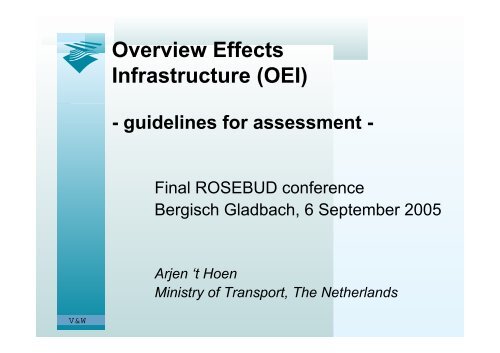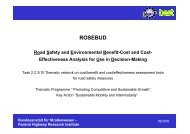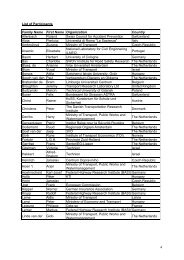Overview Effects Infrastructure (OEI) - guidelines for ... - Rosebud
Overview Effects Infrastructure (OEI) - guidelines for ... - Rosebud
Overview Effects Infrastructure (OEI) - guidelines for ... - Rosebud
Create successful ePaper yourself
Turn your PDF publications into a flip-book with our unique Google optimized e-Paper software.
<strong>Overview</strong> <strong>Effects</strong><br />
<strong>Infrastructure</strong> (<strong>OEI</strong>)<br />
- <strong>guidelines</strong> <strong>for</strong> assessment -<br />
Final ROSEBUD conference<br />
Bergisch Gladbach, 6 September 2005<br />
Arjen ‘t Hoen<br />
Ministry of Transport, The Netherlands<br />
DGP/IT V&W
Outline presentation<br />
• Explanation of <strong>OEI</strong><br />
• Contents of the guideline <strong>OEI</strong><br />
• History<br />
4. Results of 5 years <strong>OEI</strong><br />
5. Lessons learned<br />
DGP/IT V&W
1. Explanation of <strong>OEI</strong><br />
• <strong>OEI</strong> = <strong>Overview</strong> <strong>Effects</strong> <strong>Infrastructure</strong><br />
• Based on social cost benefit analysis<br />
• All relevant impacts, including<br />
- effects on road safety<br />
- distribution effects<br />
- non-monetary, quantitative and<br />
qualitative in<strong>for</strong>mation<br />
- uncertainties in costs and benefits<br />
• Compulsory <strong>for</strong> large, national transport<br />
infrastructure projects<br />
• Compulsory in two phases of the decision making<br />
process<br />
DGP/IT V&W
Two phase approach national<br />
projects<br />
Quick Scan<br />
CBA<br />
CBA<br />
start<br />
selection of<br />
alternative solutions<br />
<strong>for</strong> in-depth study<br />
second opinion<br />
DGP/IT V&W<br />
phase 1<br />
exploration<br />
of problems<br />
and possible<br />
solutions<br />
phase 2<br />
demarcation<br />
and in-depth study<br />
phase 3<br />
realisation
2. Contents of the guideline<br />
<strong>OEI</strong><br />
DGP/IT V&W<br />
• Explanation social cost benefit analysis as a<br />
framework <strong>for</strong> an integrated and transparent<br />
description of effects<br />
• Definitions of various kinds of effects<br />
• Description of methods and models <strong>for</strong> calculating<br />
effects<br />
- possibilities and limitations<br />
- no compulsory methods / models<br />
• Global indications of the size of effects related to<br />
- different market situations<br />
- different kinds of projects<br />
• A clear and uni<strong>for</strong>m <strong>for</strong>mat <strong>for</strong> presentation of<br />
costs and benefits
DGP/IT V&W
3. History<br />
• 90’s: national debate:<br />
- Betuwe freight railway line Rotterdam – Germany<br />
- High Speed Rail Amsterdam – Brussels<br />
- 2nd seaport expansion Maasvlakte Rotterdam<br />
- Expansion Schiphol Amsterdam Airport<br />
• Many reports, experts, methods and opinions on<br />
the various types of effects<br />
• Need <strong>for</strong> <strong>guidelines</strong>!<br />
DGP/IT V&W
DGP/IT V&W<br />
• 1998: initiative <strong>for</strong> developing <strong>guidelines</strong> by<br />
Ministry of Transport and Ministry of Economic<br />
Affairs<br />
• Broad group of universities, research institutes,<br />
institutes <strong>for</strong> policy analysis and consultants<br />
involved<br />
• 2000 <strong>guidelines</strong> <strong>OEI</strong> ready and presented to the<br />
Parliament:<br />
- compulsory application <strong>for</strong> all large, national<br />
infrastructure projects (not laid down by law)<br />
- compulsory second opinion<br />
• 2002: evaluation of new practice<br />
• 2004 and 2005: new supplements, including a<br />
supplement on safety effects (in preparation)
4. Results of 5 years <strong>OEI</strong><br />
• Guidelines used <strong>for</strong> all large transport infrastructure<br />
projects<br />
• More uni<strong>for</strong>mity in definitions used<br />
• Lasting, but more structured, discussions on the<br />
size of effects and the definition of the base case<br />
• Better quality of policy plans:<br />
- <strong>OEI</strong> as an instrument to separate the sheep from the goats<br />
- <strong>OEI</strong> as a process tool, leading to project optimalisation<br />
DGP/IT V&W
DGP/IT V&W<br />
• <strong>OEI</strong> more and more applied to<br />
- smaller national and regional projects<br />
- other categories of public investments<br />
• <strong>OEI</strong> as a basis <strong>for</strong> evaluation of cross-border<br />
projects<br />
– e.g. Iron Rhine, deepening Schelde waterway<br />
• Further improvements still necessary:<br />
– further integration of <strong>OEI</strong> and environmental<br />
assessment<br />
– global quantitative indicators <strong>for</strong> various types of effects,<br />
to be used in quick scan <strong>OEI</strong>
5. Lessons learned<br />
• Create broad support:<br />
- universities, research institutes<br />
- ministries<br />
• Steer a middle course between:<br />
- too abstract <strong>guidelines</strong><br />
- too many prescriptions<br />
• Legal regulations not necessary, but a clear<br />
governement’s position of vital importance<br />
• Give the proposed instrument a clear position in<br />
the decision making process<br />
• Develop a clear and uni<strong>for</strong>m <strong>for</strong>mat <strong>for</strong><br />
presentation of the results<br />
DGP/IT V&W
DGP/IT V&W<br />
• Emphasize primacy of politics<br />
• Use cost benefit analysis as a process tool during<br />
the different phases, not only as a final check just<br />
be<strong>for</strong>e the final decision<br />
• Exchange experiences gained in concrete<br />
projects<br />
• Plan evaluations of the <strong>guidelines</strong>, resulting in<br />
supplements or new versions






